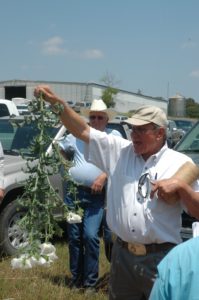Weigh Options Before Considering Restocking Beef Herds

By Blair Fannin, Texas AgriLife Extention
Restocking may be an option that many ranchers are considering, but rainfall and other factors will weigh heavily into the decision-making process, according to a Texas AgriLife Extension Service economist.
Dr. Jason Johnson, AgriLife Extension economist from Stephenville, told beef producers at the recent O.D. Butler Forage Field Day at Camp Cooley Ranch if the conditions are right "and even with high input costs, these high market prices can make you some good money." The most important issue that producers must determine, he said, is when pastures will recover from the drought and provide enough forage to consider restocking.

Dr. Barron Rector, Texas AgriLife Extension Service range specialist, displays white prickly poppy as part of a walking tour at the O.D. Butler Memorial Forage Field Day held at Camp Cooley Ranch. (Texas AgriLife Extension Service photo by Blair Fannin)
Texas pastures took a beating last year due to historic drought conditions, Johnson said. He urged producers to use caution and carefully develop a strategy to rebuild herds. Since 1971, Texas is down some 25 percent in cow inventory, he said.
"2011 was the single largest decline in beef cow numbers we’ve ever seen," he said. "All of these things are supportive of high calf prices and in support of beef overall. We are not in a situation where we are building cow-calf numbers up."
The price forecast looking ahead to April 2013 is $1.63 per hundredweight for 700-pound calves.
"Coupled with declining cow numbers, it looks like these high prices are here for a while," he said. "Cattle on feed prices are going higher as well as live cattle prices. Fewer cows, fewer calves and less beef… that’s signaling higher prices."
Other factors such as global finance crisis could affect consumer spending on beef.
"If people don’t have money to pay for electricity, they don’t have money to buy beef," he said.
In the meantime, Johnson said feedlot return margins are thin due to fewer calves available to put on feed. He said feedlots are "like hotels, and the occupancy rates haven’t been too good."
There are also infrastructure issues, such as operational costs at auction barns.
"With small runs at the auction barns, they still have to pay for overhead costs," he said.
Ultimately, if a rancher decides to restock, how much are they willing to pay?, Johnson asked. Should they buy replacement heifers or cow-calf pairs?
When it comes to replacement heifers, Johnson said beef producers should consider how much they can sell their heifers versus raising them. With market prices climbing, Johnson said producers may elect to sell those animals and make a nice profit.
"You really have to answer the question: ‘Am I willing to forgo that paycheck I would receive holding on to that replacement heifer rather than selling it?’" Johnson said. "It’s going to be two years before I get that first paycheck out of that animal if I hold on to it and raise it as a replacement."
Those that choose to buy replacements should do so through private treaty (a private buy-sell negotiation) rather than an auction barn, unless there is a special consignment sale, Johnson said.
"Where you buy them is important," he said.
Johnson also suggested ranchers consider storing up to two years worth of hay supplies to cut down costs. In 2011, hay prices skyrocketed above $300 a round bale, so he advised developing the capacity to store excess hay so producers could avoid the necessity of buying hays in extremely expensive years like last year. Other suggestions included getting soil samples so producers can apply fertilizer at an economical and recommended rate.
"You absolutely have to know your fertilizer needs and (considering) the high cost of fertilizer. Better information will lead to more efficient applications," he said. "With a soil test, you know what your pasture needs are."
Johnson also advised producers to consider purchasing drought insurance to further protect from downside operation risk.
Meanwhile, Dr. Barron Rector, AgriLife Extension range specialist, gave a walking tour that included plant identification. He discussed grazing and weed management strategies with producers. He said coming out of last year’s drought, many pastures are seeing a lot of weed growth development.
Seed from some of the weeds observed are noted to be viable in the soil for up to 15 years. Without good management and observation of pasture changes, the soil weed-seed bank will be increased this year for future years, Rector said.
"Take Broomweed for example," he said. "Every day that we come out of a drought, that weed seed bank gets replenished. Everything that happens on the land is a reflection on us as managers. To grow grass, you’ve got to get water in the soil and keep it there."
He said three-inch stubble height will retain more rainfall in the soil than forage grazed down to the surface, which will brown out faster. Pasture conditions with short grass or little cover allow the sun to heat up the soil surface more resulting in soil-water loss to the atmosphere through evaporation, Rector said.
"With knowledgeable grass management, I can keep water in the soil longer, and I can grow grass longer," he said.
Pointing to the green pastures at the ranch, Rector said, "What grass you are seeing out there right now might be what we are carrying for livestock grazing to the next hurricane in the fall."
That’s why Rector stressed the importance of grazing heights on pasture in order to preserve soil moisture. He also discussed various weed types found during the walking tour and advised producers to spray herbicides in March to get the best response time for grass growth.
"This will allow ample time for grass to grow during the optimal months (March, April and May) when we expect temperatures to be cooler and the limited rainfall we receive to hang around longer."
-30-







